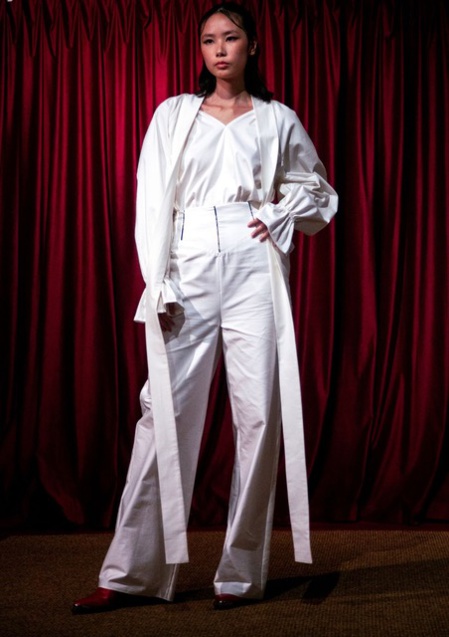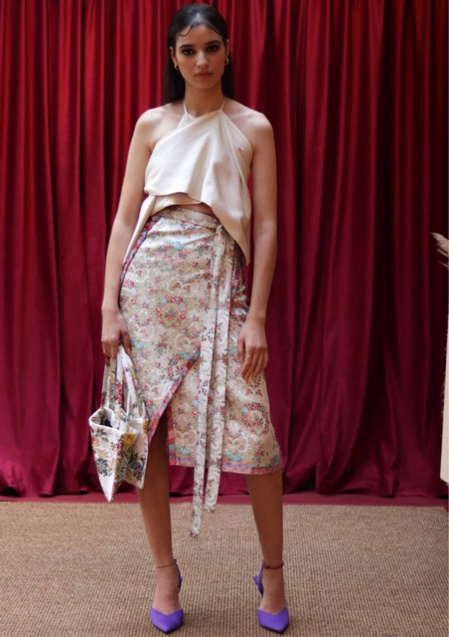We couldn’t expect less from the most brilliant emergent Spanish brand. On September 28th 2022, Teran Conde Paris unveiled its SS23 collection “Blooming”. Simply, the reflection of all the talent, joy and artistic spirit and purpose of making people feel joyful, empowered, and sophisticated of her designer Esperanza Teran Conde’s. Teran Conde Paris is a conscious fashion brand that tailors sustainable Mediterranean inspired clothes. Their approach to fashion is sustainable, reasoned and thoughtful. Between, Flamenco and luxury outfit pieces, the night was indeed full of warm vibes and happiness.
1) A gorgeous place: Hotel Villa Marquis

Paris Fashion Week: 3 ways to organize the best Spanish fashion show with Teran Conde. (c) Teran Conde | Sabine Mosser.
In Paris, a hotel has opened its doors where it is possible to feel at home while enjoying the essence of Paris. The Hotel Villa Marquis in Paris, is part of the The Meliá Collection portfolio. Located in the 8th arrondisement in Villa Marquis, residence of the Hurault de Vibraye dynasty. A charming boutique hotel that has managed to keep its glamorous legacy perfectly intact while adjusting its facilities to provide modern comforts with an avant-garde and elegant design. The Villa Marquis is known to have seen the succession of 9 marquises of the Hurault-de-Vibraye dynasty, the family that today owns the Château de Cheverny. With Victor Hugo as a neighbor, who found inspiration to write Notre-Dame de Paris on rue Jean Goujon, the Villa Marquis became a mecca for aristocracy and high society throughout the 19th century. The Villa Marquis is known to have seen the succession of 9 marquises of the Hurault-de-Vibraye dynasty, the family that today owns the Château de Cheverny. With Victor Hugo as a neighbor, who found inspiration to write Notre-Dame de Paris on rue Jean Goujon, the Villa Marquis became a mecca for aristocracy and high society throughout the 19th century. But one of the most striking things is the view of the quintessential Parisian monument. From the terraces and balconies, you can see the Eiffel Tower with one of the most appreciated views of the capital. The main restaurant of the Villa Marquis hotel is Dos Almas, so named for its blend of the best of French and Spanish gastronomy. Decorated in copper notes, the establishment is open every day for lunch, aperitifs or dinner on its velvet-covered banquettes.
2) A Mindblowing Flamenco show

Paris Fashion Week: 3 ways to organize the best Spanish fashion show with Teran Conde. (c) Teran Conde | Sabone Mosser.
To introduce the night Teran Conde delighted us with an absolut beautiful and authentic Flamenco show. Two dancers were performing live that night and let us discover in a very flawless and high level way, the technical and artistic aspect of this historical dance. The origin of flamenco is still a mystery. However, the tradition of this art was built in Andalusia, in the south of Spain. Now spread throughout the world, flamenco has been labeled in 2010 "intangible cultural heritage of humanity". Flamenco is a musical genre and a very popular dance in southern Andalusia born in the eighteenth century. The origins of this art form are still unclear. The term "flamenco" arrived in the 19th century and the origins of the word are also diverse. For some, it comes from the Arabic "Fellah Mengu", a peregrine ethnic group -a very disputed thesis since Arabic no longer had any influence in the Spanish 19th century. The term could also refer to the Gypsies who fought for Spain in Flanders. Often an allusion is made to the derogatory term that Andalusians used to refer to Gypsies as "flamencos" (Flemish, in Spanish). This artistic richness specific to flamenco, which is lost over time, makes it one of the most complex artistic disciplines. Artistic discipline, because we can not only talk about Flamenco dance. This last one is part of an indivisible trilogy: the dance, the song and the guitar. The guitar (toque), castanets and other instruments became part of the Andalusian tradition. The dance (baile) then made its entrance, whose basic characteristics crystallized from 1869, until the 1920s, the golden age of flamenco. Unlike singing, which can be performed alone, dancing is inseparable from the guitar. The dance, practiced by both men and women, goes beyond words to translate feelings. The dances are shaped by joy and suffering, they vary according to the feeling expressed. They can lead to a state of trance, of bewitchment; the creativity of the dance meets another dimension, a true moment of grace that is associated with "duende". From this conjunction of different aspects derives the musicality of flamenco, which is, by its very definition, a team effort. Listening is the key, but listening to everything and to each other. A flamenco dance can have a meaning if there is coherence between all the elements that intervene; when the artistic language becomes a continuous and harmonious dialogue.
3) A “Blooming” Fashion show and collection

Paris Fashion Week: 3 ways to organize the best Spanish fashion show with Teran Conde. (c) Teran Conde | Sabine Mosser.
In a joyful spirit, dresses, and skirts shape an empowered silhouette, rooted in a Zeitgeist luxury. Jackets, vests, and kaftans complete this modern wardrobe, where each piece of clothing celebrates cosmopolitan women. Playful items offer a reversible clothing style. The vivid color palette brings to life a new way of dressing, from cocktail to leisure, and always with sophistication. Bold glossy red, brisk forest green, bright saffron yellow, and anthracite gray unify the collection with discrete hints of peony pink and pale ivory.Handcrafted silk fabrics embody Esperanza Teran Conde vision of luxury: minimizing social and environmental impacts by creating apparel that lasts the test of time while preserving centuries-old Spanish craftsmanship. With a lust for lively sustainable fashion, Teran Conde Paris advocates for a wardrobe with a meaning, capturing both emotions and savoir-faire. Uniqueness and inclusiveness, individual and collective, intimate and ostensible. Where Parisian elegance meets Spanish heritage through the Fallas fabrics they use and a century-old savoir-faire.
The Fallas Parade, in Valencia, In March, “Las Fallas” take over the city with non-stop fiestas, gigantic artistic monuments all around Valencia, amazing bonfires, lots of music and of course, food! The main days of the festival are between March 15th-19th. The origins of the Fallas festival are rooted in commemorating the day of Saint Joseph (or San José), the saint of carpenters. As with most traditions, the Fallas gradually evolved over time. This celebration is now centered around celebrating the silk industry in Valencia and the beautiful garments that are produced as a result, it allows all participants to reflect on the history of silk in the region. Having been introduced into the Iberian Peninsula in the 8th century, the fabric brought immediate success and spread throughout up until the 18th century, establishing the formerly known al-Andalus as a center for silk production. So special the silk tradition has grown that the espolin, a jacquard-like silk woven pattern has developed as a specialty of the region. The espolin celebrates one year of its inscription into the UNESCO Intangible Heritage List in November 2016. Because this celebration is centered around celebrating the silk industry in Valencia and the beautiful garments that are produced as a result, it allows all participants to reflect on the history of silk in the region. Having been introduced into the Iberian Peninsula in the 8th century, the fabric brought immediate success and spread throughout up until the 18th century, establishing the formerly known al-Andalus as a center for silk production. Nowadays, the main use we give to this
floral-patterned fabrics is for making the traditional fallera and fallero (woman and man) costumes, which we only use during March at neighbourhood parades and processions during the fallas festival in Valencia. Born and raised between Madrid and Alicante, Esperanza always has known the tradition of the Fallas fiestas in Valencia and their specific costumes. But it wasn’t until recently that Esperanza heard that the Fallas fabric had some dormant stocks! Eventually, the idea of using Fallas fabric as a signature for Teran Conde Paris began to grow in her mind. This is how the Lolita set was born. Eye-catching and bold yet elegant, the Lolita set is the iconic piece of Teran Conde Paris.
The Fallas Parade, in Valencia, In March, “Las Fallas” take over the city with non-stop fiestas, gigantic artistic monuments all around Valencia, amazing bonfires, lots of music and of course, food! The main days of the festival are between March 15th-19th. The origins of the Fallas festival are rooted in commemorating the day of Saint Joseph (or San José), the saint of carpenters. As with most traditions, the Fallas gradually evolved over time. This celebration is now centered around celebrating the silk industry in Valencia and the beautiful garments that are produced as a result, it allows all participants to reflect on the history of silk in the region. Having been introduced into the Iberian Peninsula in the 8th century, the fabric brought immediate success and spread throughout up until the 18th century, establishing the formerly known al-Andalus as a center for silk production. So special the silk tradition has grown that the espolin, a jacquard-like silk woven pattern has developed as a specialty of the region. The espolin celebrates one year of its inscription into the UNESCO Intangible Heritage List in November 2016. Because this celebration is centered around celebrating the silk industry in Valencia and the beautiful garments that are produced as a result, it allows all participants to reflect on the history of silk in the region. Having been introduced into the Iberian Peninsula in the 8th century, the fabric brought immediate success and spread throughout up until the 18th century, establishing the formerly known al-Andalus as a center for silk production. Nowadays, the main use we give to this
floral-patterned fabrics is for making the traditional fallera and fallero (woman and man) costumes, which we only use during March at neighbourhood parades and processions during the fallas festival in Valencia. Born and raised between Madrid and Alicante, Esperanza always has known the tradition of the Fallas fiestas in Valencia and their specific costumes. But it wasn’t until recently that Esperanza heard that the Fallas fabric had some dormant stocks! Eventually, the idea of using Fallas fabric as a signature for Teran Conde Paris began to grow in her mind. This is how the Lolita set was born. Eye-catching and bold yet elegant, the Lolita set is the iconic piece of Teran Conde Paris.


















 Wanderlust Chronicles: The 5 Best Dining Experiences on Mariner of the Seas
Wanderlust Chronicles: The 5 Best Dining Experiences on Mariner of the Seas








